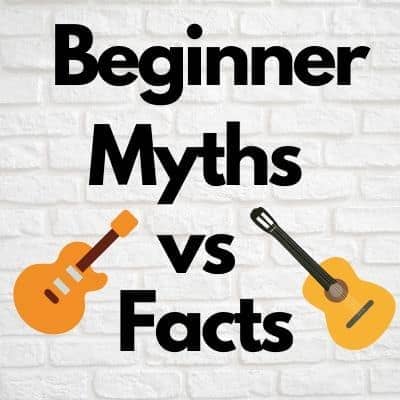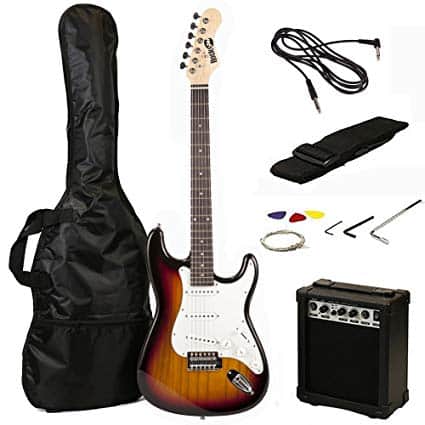
Learning to play the guitar is one of the best life choices you can make.
But like every beginner, you must choose whether to learn on the acoustic or electric guitar.
Trust me; that was a tricky choice for me when I first started my journey 17 years ago.
Luckily in this post, you will receive my 14 important tips to choose between the electric and acoustic guitar as a beginner. Everything from:
- Which guitar is easier to play as a beginner
- Does it matter what guitar new beginners choose?
- Common myths beginners hear when deciding which guitar to learn on
- The difference in sound between electric and acoustic
- What guitar to choose based on your musical tastes
- The price difference between both guitars
The Short Answer
Electric guitars are known to be easier to play for beginners as thinner strings require less fretting pressure. In contrast, acoustic strings have heavy gauge strings, thick necks, and higher action. This requires more fretting pressure to play notes, which is more uncomfortable for uncalloused fingertips.
So now we know the brief differences, let’s dive in with tip number one…
Tip 1 – Choose the Most Appealing Guitar to You
This tip is perhaps the most important! As you have probably guessed why it’s first on my list.
Whether it’s electric or acoustic, simply choose the guitar that you want to learn the most! It’s that simple, pick up the guitar that visually and tonally appeals to you.
Choosing the guitar you want to learn the most ensures you will practice, practice, and practice some more, assisting you to progress out of the beginner phase quicker.
Simply choose the guitar that…
- Inspires you the most to pick up and learn the guitar
- Injects the most drive to pick up daily and progress out the ‘beginner phase.’
- Sounds the best to your ears
- Visually appeals to you more
- It’s the most common in the genre of music you like
I like to think there is no ‘easiest guitar’ for a beginner. The easiest guitar is the one you want to learn with hunger and desire.
For example, if you love the soft and woody sound of the acoustic guitar, then pick it up and start learning.
Whereas, if you love the distorted and aggressive sound of the electric, then go for it. If you are undecided and like both guitars well, keep reading!
My First Guitar (Short Story Time)
My first guitar was a cheap and nasty steel-string acoustic from a random second-hand store. To sum it up, my first guitar was close to unplayable..
- The strings were tough and hard to press
- The body was huge and uncomfortable
- The action (height of the strings) was far too high
- The fret ends were sharp
It was challenging to play for a guitar master, never mind a beginner!
Yet I played the hell out of that thing for over a year and progressed out of the frustrating beginner phase using it.
Therefore, when it comes to you. Do not fall victim to the ‘analysis by paralysis’ trap.
Just pick up anything and start learning. The sooner you start, the quicker you will be on the ladder to progress.
To Summarize Tip #1
Although many factors come into play choosing the right instrument for you. The take-home points again are…
- Which guitar inspires you the most to pick up and learn the guitar?
- Which guitar injects the most drive to pick up daily and progress out the ‘beginner phase?’
- Which guitar sounds the best to your ears?
- Which guitar visually appeals to you more?
- Do not overthink your choice of instrument
Tip 2 – Debunking the ‘Myths’

Countless myths get tossed around when deciding between an electric and acoustic. Mostly on the web and from word of mouth.
Trust me, I have heard all of them over the years.
With that said, let’s open up the catalog of common myths and provide the truthful facts so you do not fall victim to any.
Myth 1# – “Beginners must learn acoustic first and then learn the electric guitar later.
Fact: There are no written rules when it comes to choosing your first guitar. It all comes down to personal choice, musical tastes, influences, and the guitar that overall appeals to you more.
Myth 2# – “You need to toughen up your fingers on acoustic first before jumping to electric.”
Fact: To a beginner, acoustic steel strings are tougher to fret, coming second would be electric strings, and the lightest would be nylon strings.
However, whatever guitar you play first will be tough on your fingers, so don’t waste time playing something that does not appeal to you.
Myth 3# – “You need to buy a more expensive guitar to progress faster than a cheaper guitar.”
Fact: An expensive guitar ($800+) is not the way to go for a beginner and will serve very little to help progression other than the burden of a heavy price tag. Price does not determine how fast you will progress.
The best option would be to purchase an affordable guitar within your budget. A rough guide would be around $120-$300 for an acoustic and $150-$400 for an electric guitar.
Secondly, ensure that your guitar has undergone a setup by a professional guitar tech. Some retailers include a free setup included in the price.
Myth 4# – “Beginners should learn on nylon strings first because they are softer and easier on your fingers.”
Fact: All beginners come in various age groups and sizes, from small kids, all the way to grown adults.
Therefore, a 6.5″ male will not find steel-string acoustics hard to fret and play.
Therefore, choose the guitar that inspires you to learn and the guitar you want to advance your skills on.
Myth #5 – “Hand size determines what guitar you should learn first.”
Fact: Hand size is irrelevant when choosing between an electric and acoustic. Go with your tastes and desires.
Tip 3 – Know the Pros and Cons of Electric Guitar
Pros
- Electric strings are thinner, requiring less fretting pressure to bar notes and chords.
- An electric guitar body is slim meaning you don’t have to wrap your arm around the body to strum and pluck strings
- Electric guitars have narrower and slimmer necks than acoustics
- The distance from the strings to the fretboard (known as the action) is lower. This means less finger pressure required to fret notes and chords.
- Some electric guitars have ‘contours’ to fit snug and close into your body
Cons
- Much heavier than acoustic guitars, noticeably when standing up due to the body, hardware, and electronics.
Other Things to Consider
- More resilient than acoustics
- More expensive than most beginner acoustics
- Have to buy an amplifier and cable, resulting in more money to get a full set up
- Less likely to scratch
- You can use headphones plugged into a practice amp with electric for silent playing
The electric can also benefit beginners just starting as it is slightly easier to play having thinner strings, thinner necks and slimmer body than acoustics (mentioned above.)
But do not let this persuade you too much, go for the guitar that overall appeals.
Tip 4 – Know the Pros and Cons of Acoustic
Pros
- More space in between frets resulting in more space for fingers
- Nylon string acoustics are the softest strings which won’t hurt your fingers
- Lighter than electric guitars
Cons
- Acoustic Steel-strings are a heavier gauge and can cause more discomfort for beginners when starting out.
- Fingers will hurt more when just starting out on steel-string acoustics
- Features a thicker and wider neck than an electric guitar
- The acoustic guitar body is bigger and wider resulting in less comfort
Other Things to Consider
- Cheaper than beginner electric guitars for beginners
- Lighter than electric guitars
- Don’t need an amplifier
- Softer and natural tone
- Perform anywhere without any additional gear
Tip 5 – Understand the Sound of Electric
So why play the electric guitar instead of the acoustic? Well, the main reason is that the electric guitar is diverse, open to a large array of sounds, tone sculpting possibilities, experimentation, and guitar playing styles.
Hence why the electric guitar is associated with so many genres of music. So if you like many types of music then the electric can be a superb choice for you.
The reason the electric guitar is so diverse is that being electric allows players to modify the guitar’s sound and tone to your preferences and tastes.
How Do Electric Guitars Work?
Electric guitars include 1 or up to 3 ‘pickups’ fitted within its body. These pickups function by taking the vibrations from the string from the notes played as an analog signal.
This signal is relayed through a guitar cable (plugged into your guitar) to any effects or an amplifier for tone modification or larger sound projection.
So the electric signal can now be modified with…
- The guitar’s controls (tone, volume, pickup selection)
- A guitar amplifier (gain, treble, mid, bass, reverb, master volume, additional effects)
- Guitar effects/stompboxes (distortion, octave, flanger, delay fuzz, wah, phaser, chorus, etc)
So as you can see with all these options, the electric guitar is so tonally diverse with all possibilities for sounds, effects combined with different playing styles.
Iconic Electric Guitar Tones
Some common and identifiable electric guitar tones you may be familiar with are…
- Heavy distortion – Metal
- Mild distortion – Rock
- Crunchy distortion and warm overdrive – Blues
- Clean tone – Modern
- Warm clean tone – Jazz
- Thin and Bright clean tone – Country & Funk
Electric Guitars Sustain
Another thing that separates an electric from the acoustic, is the additional amount of sustain available from an electric.
Sustain is known as the amount of time a note is audible when plucked before it eventually fades out.
Lead guitarists love sustain for solos and general lead noodling. The ambient guitarist also loves sustain for producing long trails of swelled notes or chords using a volume pedal.
Tip 6 – The Acoustic Guitar Tone

The acoustic guitar amplifies its sound (you guessed it)…‘acoustically,’ which is a different sound and tone compared to the electric altogether.
The acoustic sound is softer, richer, and a woodier tone compared to the electric guitar.
The acoustic guitar is seen as more minimalist and is typically ‘see what you get!’
However, the acoustic is still a diverse instrument as this guitar is the usual weapon of choice for mellower, romantic, softer and emotional styles of music.
But historically, it is also favored for rock, blues, country, folk, and classical music.
How Acoustic Guitars Get Their Sound
With a full acoustic guitar, the sound and tone it creates are primarily ‘set in stone.’
The individual sound from each acoustic can vary depending on the design and construction of the guitar.
For example….
- Body type (dreadnought, Jumbo, XL, etc)
- Main body Wood (Mahogany, Maple, Tonewood, Basswood)
- Fretboard wood
- Scale length
- Strings (steel, nylon)
- String gauge (thickness of the strings)
- How hard you play
How Acoustics Amplify its Sound
- When the strings vibrate, the vibrations travel to the guitar’s saddle
- The saddle transfers these vibrations to the soundboard
- The soundboard and body amplifies the sound (loudness and tone depends on the guitar’s construction)
- The sound comes out and amplified through the soundhole
The Electric Acoustic
The electric acoustic guitar is identical to a full acoustic guitar. The only difference is that an electric-acoustic includes an electronic pickup within its body.
This allows for the best of both worlds, as it enables players to amplify the acoustic sound to an amplifier, PA system, or to an audio interface for amplification or recording.
An electric acoustic with a pickup will include some EQ options on the side of the guitar including
- Treble
- Bass
- Mid
- Boost
- Presence
Some models will also include a built-in tuner that is handy for very quickly getting you back in tune, allowing you to develop an ear for the correct pitch quickly.
Tip 7 – Know your Favorite Musical Genre

When deciding on electric or acoustic, your favorite genre of music will highly influence your decision when wanting to learn guitar.
For me, I always wanted to learn classic rock and blues as a teenager, so the electric guitar was always the number one choice for me.
Your favorite type of music and the guitar heroes that play in the genres are going to be your biggest influence.
For example, here are the different genres of music associated with electric and acoustic… So ask yourself what music do you like?
And is it the electric or acoustic that appears in the majority of genres you enjoy listening to.
Electric Guitar
- Jazz
- Metal
- Punk
- Rock
- Blues
- Country
- Pop
- Reggae
- Latin
- Funk
Acoustic Guitar
- Bluegrass
- Folk
- Flamenco
- Country
- Singer-songwriter
- Rock
- Blues
- Pop
- Latin
- Classical
Tip 8 – Know Your Guitar Heroes
Musical influences shape the path a player follows when learning and progressing on the guitar.
Beginners are likely to pick out a guitar simply because their guitar heroes mastered their trade on it.
Who Are Your Guitar Influences?

So simply, who are your guitar heroes and what music do they play?
Watch videos on YouTube and ask what guitar is their weapon of choice for their type of music?
Perhaps they play a mixture of both electric and acoustic. Here are some examples…
So you like Eddie Van Halen, Kirk Hammet, Dave Mustaine, and Zak Wylde then electric is for you my friend.
Or you like Ed Sheeran, Jason Mraz, Andy Mckee, and Bob Dylan then acoustic is for you.
Or you like Jimmy Page, Jimmi Hendrix, Slash, and Eric Clapton then electric is for you my friend.
There may be instances when you like bands such as Oasis, Foo Fighters, The Who, and the Beatles. In this instance, you seem to like both electric and acoustic.
Therefore, knowing what your guitar hero’s play provides a slight influence on whether you start your journey on the electric or acoustic guitar.
Tip 9 – How to Choose an Electric Guitar
Electric guitars come in many shapes, sizes, specs, and features. And with this, it’s very easy to become overwhelmed when choosing an electric.
Fear not, this tip will help you out.
The good news is, you should forget technical specs altogether. As a beginner, you should simply choose a guitar from 3 aspects…
- Guitar body shape that appeals to you
- What your guitar heroes play
- The musical genres you want to play
Let’s discuss them in more detail
Choose the Right Shape
When just starting out, you just need to play as often as you can, period!
Importantly, What will aid this is having a guitar that inspires you visually and tonally which provides you the most motivation to frequently practice and progress as fast as possible.
When choosing a guitar as a beginner, you also listen with your eyes, so choose the electric guitar that appeals and inspires you the most. Popular shapes and models of electrics are…
- Les Paul
- Stratocaster
- Telecaster
- SG
- Metal Superstrat (Ibanez, Jackson, ESP)
- Firebird
- Explorer
- Flying V
- Semi-Hollow body
- Hollow Body
What Guitar Does your Guitar Hero Play?
When you choose the guitar that your musical influences play. Naturally, the guitar will be set up for the musical genre you mostly want to play and learn.
It will also give you the motivation to learn and pick up the guitar daily to progress as much as possible.
Think to yourself… pick three of your guitar idols. Now ask yourself…?
- What guitars do they play?
- What is their musical genre?
- Do you want to learn their style?
- Do you want to play in that genre?
Choosing My First Electric Guitar
Take me, for example, In my early teens, ‘Guns N Roses’ and ‘Led Zeppelin’ were two of my favorite bands growing up.
Therefore, Slash and Jimmy Page were both two guitar players who massively influenced me.
So what guitar did I want more than anything?
Obviously, the Les Paul guitar was my number one choice when I bought my first electric.
Your Musical Genre
If you have several musical influences in multiple genres equally, you will need a versatile guitar.
Secondly, if you don’t have any guitar heroes yet and enjoy a wide range of music, then simply choose a guitar that is versatile in many genres.
Recommended Beginner Electric Guitars
The Stratocaster and Les Paul are both guitars are icons of the guitar industry and are popular choices for most beginners as they look, sound, and feel great.
They both cover a large number of genres and known for being super versatile across the wide musical spectrum.
Les Paul
- Rock
- Blues
- Metal
- Country
- Punk
- Jazz
- Pop
Stratocaster
- Rock
- Blues
- Country
- Jazz
- Pop
- Funk
- Reggae
Tip 10 – Know a Good Price Range for Electric
Most electric guitars aimed at beginners price around $70 to $350.
I do not recommend an expensive first guitar ($400+) when just starting out.
Why splash out on an expensive instrument before knowing if you or the person you are buying for, will stick with it for the long run?
Also, you or that person will not have developed an ear or feel for what instruments sound and play better than others.
I would not waste your time on an expensive first guitar, save your hard-earned dollar.
Best Affordable Beginner Brands
There are a ton of great companies nowadays that produce fantastic entry-level guitars that are correctly set-up, quality, and at an affordable price perfect for beginners and intermediates.
So there’s no reason to buy an expensive instrument that carries the burden of a hefty price tag. Some great beginner companies that I recommend are…
- Epiphone
- Squire
- Harley Benton
- Ibanez
- Gear4music
- Eastcoast
- Stagg
- Jackson
Starter Pack or Not?
When looking to purchase an electric, you will ponder the choice of whether to buy the guitar separately or put all your eggs in one basket and buy a starter pack.

The starter pack includes everything you need including…
- Electric Guitar
- Guitar amp
- Cable
- Tuner
- Strap
Starter packs are excellent, and they provide you with everything a beginner needs. However, there are pros and cons of purchasing a starter pack compared to buying everything separately…
Pros
- Everything included; getting started
- Don’t need to hunt around for the separate gear
- Perfect for beginners
- Most popular companies do starter packs so lots of choices
Cons
- More expensive than the single guitar
- Limited in choice of desired guitar and amp
- Some guitars need setting up correctly (intonation, action, etc) to save cost
- Some guitars can be very cheap and nasty
Ultimately it is down to personal choice whether to purchase a starter pack or not. If you are completely new and want everything ready to go, then a starter pack is the way to go.
If you have your eye on a specific guitar or amp separately, then it would be better to purchase everything individually.
Tip 11 – Know about Steel and Nylon Acoustic Guitars
If you have your eyes firmly set on playing acoustic guitar. Next, you will need to decide on a steel string or nylon acoustic.
Now keep in mind, neither is better than the other. Your choice ultimately comes to musical tastes, feel, and the style you want to learn.
Let’s look at them both more closely.
Steel String Acoustic
The Steel-string acoustic is the most common and general type of acoustic you will most likely come across.
Used for modern and historically western music, tonally, the steel-string acoustic is famed for having a bright and rich sound.
The steel acoustic also comes in many variations and sizes most commonly ‘Dreadnought,’ ‘OM’ and ‘Parlor.’
In terms of playability, steel-string requires the most finger strength to fret notes and chords, which can be more tricky for a complete beginner without finger callouses.
Over time this will not be an issue as finger strength and callouses will be established the more you play and practice in the initial stages.
- The crisp and bright tone
- Modern sound
- Harder on the fingertips for beginners compared to nylon
- Holds tuning better
- Most recognizable acoustic
Common Genres
- Blues
- Rock
- Folk
- Country
- Pop
Nylon/Classical Acoustic
The nylon acoustic sometimes referred to as a ‘classical guitar’, is a different flavor compared to the conventional steel-string acoustic.
Spanish, flamenco, Southern American, and classical players are the most common players to adopt nylon acoustic guitars.
The main difference between both acoustics is classical guitar strings are made from the filament nylon instead of metal, affecting both playability and tone.
Nylon strings are softer to touch, being easier to play for beginners as nylon strings do not dig into your fingertips as much as steel strings.
Nylon Acoustic Tone
Nylon also produces a warmer and softer tone compared to steel-string acoustics.
Other differences are that nylon acoustics have more space in between frets meaning more space for placing fingers accurately.
The downside is that nylon/classical guitars have fatter necks than steel acoustics.
- Warmer tone
- Classical sound
- Easier on the fingertips for beginners
- Slightly wider fretboard (more space for fingers)
Common Musical Genres
- Classical
- Flamenco
- Spanish
- Latin America
Steel or Nylon Acoustic for a Beginner?
I must admit, nylon strings are softer and will not hurt your fingers as much as steel strings.
Now for a beginner, it would seem nylon acoustics are the best choice for an absolute beginner. However, going back to our previous point.
Choose the guitar that will give you the motivation and inspiration to pick up and play the most.
If you intend to play rock, blues, and pop then the steel-string acoustic is the best choice for you my friend.
Classical, Spanish, and fingerstyle players should learn on the nylon acoustic first based on their ideal genre. Again it all comes to personal choice.
Tip 12 – Know a Beginners Price for an Acoustic
Most acoustic guitars start from $30 on the low end all the way to the premium range of $4000+!
Why You Should Spend More on an Acoustic
Although everyone’s budget is different. I would advise spending at least over $180 for an acoustic even if it is for a first guitar.
The reason is that some cheap acoustics are difficult to play for a beginner, with some cheap and nasty ones $20-$70 being totally unplayable.
And for this point alone, I would not advise going for the cheapest acoustic you can get your hands on.
Although it can be tempting to paying under $100 an Amazon for an acoustic? I suggest you pay more to avoid a difficult and close to unplayable guitar from China.
I suggest you have a budget of $180 – $500 for a decent acoustic guitar to ensure you get a playable and good quality acoustic to assist learning.
Why Cheap Acoustics are Harder to Play
Cheap acoustic guitars are crafted from cheap materials and not set up correctly meaning playability straight out of the box is terrible.
For example, the height of the strings (known as the ‘action’) can be too high. Requiring a lot of pressure from the fingers to fret and bar notes and chords.
For a beginner with fleshy fingertips, this is not ideal as it causes further discomfort. Especially with steel strings that are the thickest and toughest out of all strings.
The pain can be uncomfortable; it can cause beginners to quit altogether before they can build up any learning momentum with the guitar.
I admit, learning steel acoustic first will cause slight pain in the fingertips at first. There’s no way around it. However, having a badly set up guitar will not help and work against you even more.
Get it ‘Set up’ by a Professional Tech
I would always advise buying an acoustic guitar from a reliable instrument retailer with a professional ‘set up’ service from a guitar tech included in the price.
Depending on the retailer, guitars can be bought online and delivered without a professional adjustment to save money (Amazon being one of them.)
For this reason, I would advise paying a little extra from a guitar retailer that will set up the guitar through an experienced tech before delivering.
Why Having a guitar ‘set up’ is important
The reason is that an affordable guitar that is correctly adjusted (string height, bridge, saddle, intonation) is better than an expensive guitar without a professional set up.
So for having a guitar that works and is playable from the start will be the best option when choosing to play acoustic.
Tip 13 – Learn Electric and Acoustic (At Some Point)
In your early days of learning guitar, I would advise you to pick either acoustic or electric and stick with it for a while.
Further down the road, however, you should branch out learn to play on both guitars. Learning and playing on both will certainly benefit you as a player.
As a guitar player, do not limit yourself to playing and learning on one type of guitar. Branch out and learn electric and acoustic.
Basically, be a curious explorer and student of the world of guitar. Do not shackle yourself to your own ways for too long.
Benefits of Learning on Both Guitars
So why should you learn and play on both guitars further down the line? Here’s why…
- More tools you have in your toolbox as a guitarist will make you a better-rounded player.
- Introduce you to different genres and styles of guitar playing.
- You can take both these styles interchangeably to the acoustic and electric.
- Take your acoustic fingerstyle to your electric for a different sound.
- Take your lead playing learned from the electric to your acoustic for softer and melodic solos.
- It is similar to learning the guitar again opening a new world of sounds.
- Keeps learning fresh and interesting.
Tip 14 – Have Fun and Enjoy Learning Guitar
Regardless of what guitar you choose – electric or acoustic, enjoy the path of learning the guitar.
And remember, the journey is much more fun than the destination.
As a beginner, you just need to start your journey. Thank you for reading the post to the end. I hope you enjoyed it as much as I did writing it.
Thanks For Reading
If you enjoyed this informative pillar post? You should check out my awesome related post…
“How to make an electric guitar sound like an acoustic guitar.”
It’s my how-to guide on converting any electric guitar to sound like a lush and woody acoustic.
.

